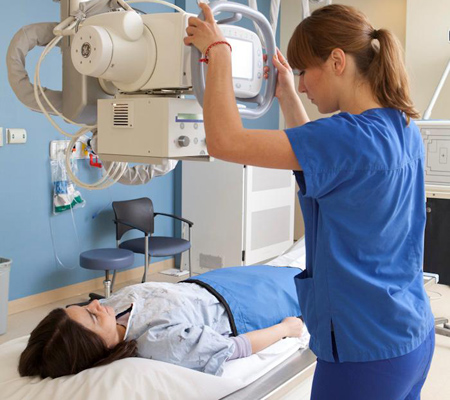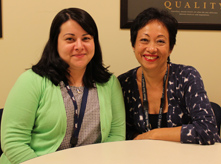
An X-Ray Technologist performing an imaging scan on a patient at Toronto General Hospital
It began over 20 years ago. Janet Pereira-Ross was a high school student volunteering in medical imaging at Mount Sinai Hospital. Lilace Hudson was a Charge Technologist in the same department, and also filled the role as Pereira-Ross's supervisor.
Fast forward to today. Pereira-Ross works as X-Ray/CT Supervisor for Toronto General and Hudson works as Clinical Manager for Medical Imaging at Mount Sinai Hospital. Both work in the same medical imaging department, the Joint Department of Medical Imaging (JDMI). It's a multi-site medical imaging program comprising the University Health Network, Mount Sinai and Women's College Hospitals.
As the largest sub-specialty medical imaging department in Canada, the JDMI includes 75 radiologists and over 800 employees, about 450 of which are medical radiation technologists (MRTs). JDMI technologists perform various medical imaging procedures on pediatric, adult and oncology patients, and specialize in the modalities of Breast Imaging, Computed Tomography (CT), General Radiography (X-Ray), Magnetic Resonance Imaging (MRI), Nuclear Medicine, and Vascular and Interventional Radiology.
Over the years, Pereira-Ross and Hudson have developed deep roots in medical imaging. Not only do they share a personal bond, but a strong point-of-view on the classification of an MRT – a definition held by many in the profession, and one which is often misconceived.
Title is 'Technologist'
"The proper term is 'technologist' – not 'technician', but they're commonly mixed up or used interchangeably," said Pereira-Ross. "Our field requires extensive training, and we take the time to learn the correct protocols and intricate knowledge to help assess and perform the best possible test for the patient – it's not just about pushing buttons."
MRT Week, which runs November 2 to 8, recognizes the critical role that MRTs play in the healthcare system.
Using medical imaging equipment to produce images of the body, MRTs are registered healthcare professionals who perform diagnostic and therapeutic imaging exams while interacting with patients. They work alongside physicians and nurses to help diagnose illness, support medical research opportunities and offer a personalized approach to patients.
"As a technologist, you're an advocate for the patient," said Hudson. "You become an expert in your modality, ensuring that in collaboration with the Radiologist, the proper exam is performed for the patient. In doing so, you become a central resource for the entire healthcare team involved in that patient's care."

Janet Pereira-Ross (left) and Lilace Hudson from the Joint Department of Medical Imaging (JDMI)
Digital diagnostic tools
The role of an MRT has evolved with the advancement of technology. Today's digital diagnostic tools allow for a multitude of options such as 2D, 3D and 4D, and black-and-white or in colour for producing high quality and precise imaging at an extremely efficient pace. Two decades ago, one CT scan took one hour to complete, whereas nowadays, the team can generate four scans within the hour.
This growth in technology has inevitably resulted in an increased request for imaging scans. A higher volume of scans is being performed now more than ever.
"Because of today's advanced imaging technology capabilities, we see the widest spectrum of patients throughout our hospital departments," said Hudson. "This speaks to MRTs as key players in the healthcare community, as their expertise is utilized in just about every area of the hospital."
The foundational skills, knowledge and training developed and implemented in the MRT field proves integral to the overall functioning of the healthcare system. With exposure to a breadth of departments requiring their specialized knowledge, MRTs stay well-connected to many areas within health care.
Of course, the role also has underlying perks in and of itself.
"What makes being an MRT so special is that there's a plethora of state-of-the-art technologies at your fingertips," said Pereira-Ross. "In this way it's about the technology, while at the same time, you still have the opportunity to make physical contact with the patients and care for them first-hand – it's really the best of both worlds."
